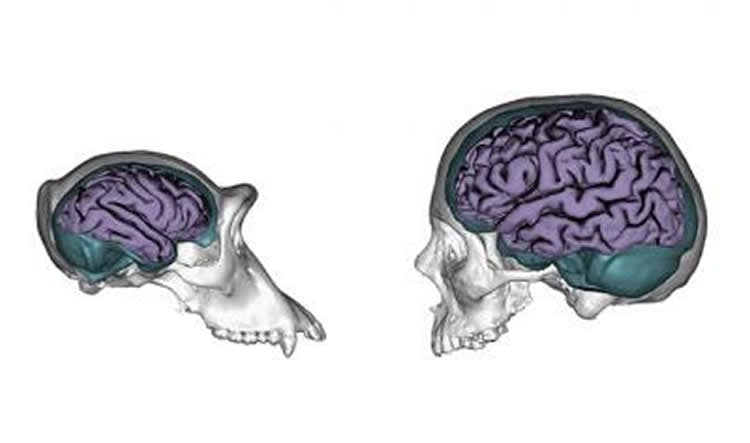Research examines genetic influence on size and organization of human and chimpanzee brains.
Chimpanzees are our closest living relatives, but what is it about the human brain that makes us so different? Researchers at the George Washington University may have unearthed another piece of the puzzle. In a study published on Nov. 16, scientists discovered that human brains exhibit more plasticity, propensity to be modeled by the environment, than chimpanzee brains and that this may have accounted for part of human evolution.
This study, the first of its kind to examine the heritability of brain organization in chimpanzees compared to humans, provides a clue as to why humans are so capable of adapting to various environments and cultures.
The research team studied 218 human brains and 206 chimpanzee brains to compare two things: brain size and organization as related to genetic similarity. The human brains were from twins (identical and fraternal) or siblings; the chimpanzee brains had a variety of kinship relationships, including mothers and offspring or half siblings. The study found that human and chimpanzee brain size were both greatly influenced by genetics. In contrast, the findings related to brain organization were different for chimpanzees and humans. In chimpanzees, brain organization is also highly heritable, but in humans this is not the case.
“We found that the anatomy of the chimpanzee brain is more strongly controlled by genes than that of human brains, suggesting that the human brain is extensively shaped by its environment no matter its genetics,” said Aida Gómez-Robles, postdoctoral scientist at the GW Center for the Advanced Study of Human Paleobiology and lead author on the paper. “So while genetics determined human and chimpanzee brain size, it isn’t as much of a factor for human cerebral organization as it is for chimpanzees.”

The paper was published in the Proceedings of the National Academy of Sciences.
“The human brain appears to be much more responsive to environmental influences,” said Dr. Gómez-Robles. “It’s something that facilitates the constant adaptation of the human brain and behavior to the changing environment, which includes our social and cultural context.”
Source: Emily Grebenstein – George Washington University
Image Credit: The image is credited to Jose Manual de la Cuetara/Aida Gomez-Robles
Original Research: Abstract for “Relaxed genetic control of cortical organization in human brains compared with chimpanzees” by Aida Gómez-Robles, William D. Hopkins, Steven J. Schapiro, and Chet C. Sherwood in PNAS. Published online November 16 2015 doi:10.1073/pnas.1512646112
Abstract
Relaxed genetic control of cortical organization in human brains compared with chimpanzees
The study of hominin brain evolution has focused largely on the neocortical expansion and reorganization undergone by humans as inferred from the endocranial fossil record. Comparisons of modern human brains with those of chimpanzees provide an additional line of evidence to define key neural traits that have emerged in human evolution and that underlie our unique behavioral specializations. In an attempt to identify fundamental developmental differences, we have estimated the genetic bases of brain size and cortical organization in chimpanzees and humans by studying phenotypic similarities between individuals with known kinship relationships. We show that, although heritability for brain size and cortical organization is high in chimpanzees, cerebral cortical anatomy is substantially less genetically heritable than brain size in humans, indicating greater plasticity and increased environmental influence on neurodevelopment in our species. This relaxed genetic control on cortical organization is especially marked in association areas and likely is related to underlying microstructural changes in neural circuitry. A major result of increased plasticity is that the development of neural circuits that underlie behavior is shaped by the environmental, social, and cultural context more intensively in humans than in other primate species, thus providing an anatomical basis for behavioral and cognitive evolution.
“Relaxed genetic control of cortical organization in human brains compared with chimpanzees” by Aida Gómez-Robles, William D. Hopkins, Steven J. Schapiro, and Chet C. Sherwood in PNAS. Published online November 16 2015 doi:10.1073/pnas.1512646112






